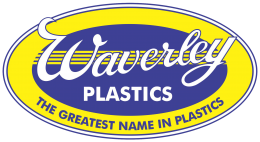Recycling for a Cleaner Future
Waverley Plastics is now recycling H.D.P.E. as an initiative to clean up Zimbabwe.
Recycling HDPE – Type 2 Plastics
HDPE, or type 2 plastics, are high-density polyethylene. These plastics make up the heavier containers that many of our everyday goods are stored in. A person can look at the bottom of a type 2 plastic and see the number 2 surrounded by a triangle of arrows and the abbreviation HDPE underneath it. The types of containers that are embossed with this code are:
- Milk containers
- Shampoo bottles
- Maheu drink bottles
- Dairy/juice bottles
Many people consider Tupperware to be one of the greatest containers ever made, and of course, it is made HDPE. That says a lot about the strength of HDPE and makes it increasingly important that this plastic is recycled. When it is recycled, it is made into:
-
- Piping (Made at Waverley Plastics)
- Plastic Containers (Made at Waverley Plastics)
- Plastic lumber
- Rope
- Toys
- Trash cans
- Recycling bins
Just like the type 1 plastic that makes up soda and water bottles, Type 2 Plastics (and also Type 4 plastics) are widely accepted at recycling centers because recycling these materials can reduce the cost of products made from these plastics. Recycling a plastic is much more cost-efficient than creating it from scratch, therefore the cost of the materials use has a reflection on the overall cost of the product. And, just as with Type 1 plastics, recycling type 2 plastics also has the same effect of curbing the cost of products packaged within these plastics. It is also important to recycle HDPE for reasons that new products are developed from them.
Tips / Do’s and Don’ts of Recycling HDPE Type 2 Plastics
Plastic bags must be clean and free of debris. Any foreign objects left in plastic bags will contaminate the plastic as it is being recycled.
- Remember to look on the bag to see what type of plastic it is. Bags for bread and other products are often made from type 2 or type plastic, both of which are recyclable. If the bag is marked with a number 7 it is not recyclable.
While it is a good idea to recycle your plastic grocery bags, not every recycling facility accepts them. It is a good idea to recycle these bags at the grocery store from which they came. Most grocers have their own bag recycling program. The reason for this is because each bag, whether it is a type 2 or 4, will have a different melting point, and even though they look the same they aren’t.
Don’t put your recyclables in a plastic bag and tie it shut. The workers in the recycling facilities do not have time to open bags and sort its contents so all bags found tied shut are thrown into regular garbage and ends up in the landfill. This totally negates your recycling efforts.
- In order to keep the materials here in the Zimbabwe the market for recycled goods needs to be supported by us. If we want recycled plastic products to be made in Zimbabwe we have to purchase the plastic items that are made using recycled plastic.
- A margarine tub is made from type 5 plastic, the lid from type 2 plastic. However, the lid of your margarine containers is not being recycled because they are not the right type 2. They have a different melting point than type 2 plastic bottles so they are not useful for the end markets.
- If it is type 2 and has a neck, recycle it.
Keep in Mind: If the market isn’t there for recycled items, no companies will continue producing them.
Importance of Recycling
Recycling is important for many reasons and we hear about those reasons all of the time. We hear that it is good for the environment, easy on the pocket book, and reduces landfill waste. With equipment such as balers making recycling much easier, it is no wonder there is such a fast acceleration of recycling taking place. However, even with this acceleration taking place, 75% of recyclable materials are still landing in landfills and not serving any purpose. With a little effort and some basic understanding this 75% statistic can be reduced greatly if businesses will just take a few steps to get started.
Just like other recyclables the basic benefits of HDPE Recycling are as follows:
- HDPE Recycling will remove the HDPE plastic from the waste stream which means waste disposal costs can be reduced.
- HDPE Recycling will provide a means of generating revenues from the HDPE plastic that is separated from the waste stream (that is destined for the landfill).
- HDPE Recycling can lower waste processing labor costs (that are required for handling the trash destined for the landfill.)
- HDPE Recycling can be instrumental is streamlining overall waste processing operations.
- HDPE Recycling can help with workplace safety and neatness such as the reduction of fire hazards (caused by excessive temporary storage of accumulated waste materials that include HDPE).
Recycling Equipment Considerations for HDPE
Many facilities have a need to dispose of HDPE and the use of a baler for recycling the HDPE can be very instrumental in making it feasible. Whether it is a large manufacturing or institutional facility, warehouse, military base or other type of commercial application, the benefits of recycling can be greatly enhanced with the implementation of a baler. Vertical and Horizontal balers are used in a large variety of environments that need to recycle a large amount of a single material or a series of materials. In lieu of loose materials causing numerous unnecessary trips to store, load and haul the recyclable, an 800 pound bale can turn recycling into a big plus instead of a negative. In addition to creating revenues from waste the time saved can greatly increase overall productivity not to mention the output of HDPE to the recycling center.
Although recycling centers utilize balers they are happy to receive HDPE from recyclers who have already taken care of the baling. The recycling center can focus on the recycling process instead of chasing around loose pieces of plastic.
With the use of a baler, bale weights of HDPE can be up to 550 Kgs however to get those kind of bale weights it will require a large cylinder (such as a 10 inch cylinder) and plenty of platen force. A 30” High Density Baler can produce bale weights of about Kgs. The difference in price and the amount of space between these two balers is huge. There is also a variety of 60" Vertical Balers that are popular for HDPE Recycling such as the 60" Economy Extra High Density Baler.

